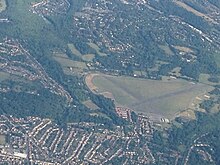RAF Kenley
originally built for the Royal Flying Corps in the First World War it radically rebuilt in August 1939 in preparation for future operation of new aircraft, such as the Hawker Hurricane, Supermarine Spitfire and Bristol Blenheim.
Unsuitable hangars from the First World War were demolished, and two concrete runways were built, plus perimeter track, blast pens, increased storage for fuels and oils, and a dedicated armoury.
Hammond Innes' book Attack Alarm, published in 1941, was based on his experiences as a Royal Artillery anti-aircraft gunner at RAF Kenley during the Battle of Britain.
32 Squadron RAF from 1923 to 1926, and the British ace JE "Johnnie" Johnson, later Air Vice-Marshal, who took over the Canadian wing at Kenley in 1943.
In December 2005, the Grade II Listed former officers' mess building and surrounding land was sold to residential building developer, Comer Homes,[citation needed] and having more recently suffered a fire and vandalism, its future is uncertain as is that of the Royal Air Forces Association (RAFA) Portcullis Club.
Part of the former air station is preserved as a tribute to the service personnel of the Commonwealth and Allied fighter squadrons who shared the honours with the RAF.
The aerodrome was used as a location in Angels One Five (1952) and Reach for the Sky (1956),[citation needed] the latter about Douglas Bader who was posted to RAF Kenley in 1930 No.
At the foot of the memorial is inscribed the war-time quote commemorating the Battle of Britain "Never in the field of human conflict, has so much been owed by so many to so few – Winston Churchill 1942."




